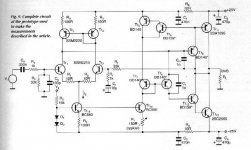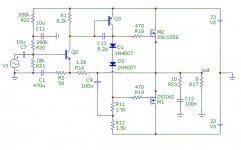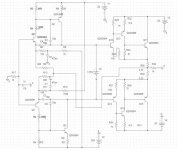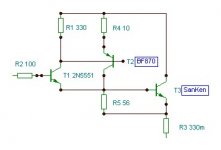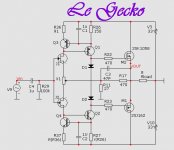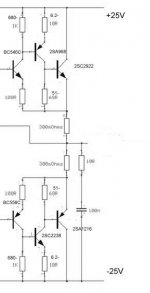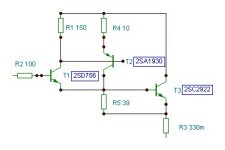For my project, at least 6 identical amps for active speakers, I considered 3 different topologies.
QUAD303 redesign.
The main feature, the Quad triple cascade, has excellent dynamic
quiescent current stability. The original quasi complementary had an almost ideal harmonics spectrum very much alike a triode push pull amp in class AB.
The harmonics spectrum of the complementary has less h2 but
higher h3 and is hence not ideal.
The main disadvantage is the triple cascade is prone to oscillation if fast power BJTs are used, I found that the fT should not be higher than 3 MHz so ring emitter BJTs cannot be used without compensation.
Jager topology
This was described in Electronics World Dec 1999 issue.
It features good thermal stability , fast recovery from saturation
in case of clipping, and in AB operation significantly reduced crossover disortion.
However the lead lag compensation requires some care and the stability comes at the price of a low slew rate of 5V/usec.
Feedforward error corrected amp
The JAES paper auhtored by Vanderkooy and Lipschitz has a brilliant analysis by Hevreng that covers all those open questions
of the Albinson and Walker paper on QUAD current dumping amp.
I made a test circuit with N5534 and BD139/140
and at least with a not too reliable software spectrum analyzer
distortion h2 h3 disappeared but higher harmonics did not.
Subjectively the best sound is produced by Quad303 redesign and worst is feedforward error correction but this is a first try
with poor quick and dirty PCB layouts and the error corrected amp was limited to 1 watt output power.
QUAD303 redesign.
The main feature, the Quad triple cascade, has excellent dynamic
quiescent current stability. The original quasi complementary had an almost ideal harmonics spectrum very much alike a triode push pull amp in class AB.
The harmonics spectrum of the complementary has less h2 but
higher h3 and is hence not ideal.
The main disadvantage is the triple cascade is prone to oscillation if fast power BJTs are used, I found that the fT should not be higher than 3 MHz so ring emitter BJTs cannot be used without compensation.
Jager topology
This was described in Electronics World Dec 1999 issue.
It features good thermal stability , fast recovery from saturation
in case of clipping, and in AB operation significantly reduced crossover disortion.
However the lead lag compensation requires some care and the stability comes at the price of a low slew rate of 5V/usec.
Feedforward error corrected amp
The JAES paper auhtored by Vanderkooy and Lipschitz has a brilliant analysis by Hevreng that covers all those open questions
of the Albinson and Walker paper on QUAD current dumping amp.
I made a test circuit with N5534 and BD139/140
and at least with a not too reliable software spectrum analyzer
distortion h2 h3 disappeared but higher harmonics did not.
Subjectively the best sound is produced by Quad303 redesign and worst is feedforward error correction but this is a first try
with poor quick and dirty PCB layouts and the error corrected amp was limited to 1 watt output power.
Attached pls. find the Jager amp schematics copied from Electronics World Dec. 1999
The CMRR of the input topology is quite high thus no separate power supply is required. However the author's claim of excellent thermal stability could not be confirmed. It was demonstrated with full load 100 W into 2 Ohms real load but I tested with 1/2
max power in 4 Ohms which gives max dissipation and there the thermal stability was good but not excellent, the quiescent current set to 100 mA had increased to 155 mA after 2 hours.
The sonic qualities are good but not superb I tested with Manger and Jordan JX53 subjectively "something is wrong" but I could not specify exactly what it is.
The CMRR of the input topology is quite high thus no separate power supply is required. However the author's claim of excellent thermal stability could not be confirmed. It was demonstrated with full load 100 W into 2 Ohms real load but I tested with 1/2
max power in 4 Ohms which gives max dissipation and there the thermal stability was good but not excellent, the quiescent current set to 100 mA had increased to 155 mA after 2 hours.
The sonic qualities are good but not superb I tested with Manger and Jordan JX53 subjectively "something is wrong" but I could not specify exactly what it is.
Attachments
hahfran,
The signal route is not straightforward, I am not a follower of that school of art.The sonic qualities are good but not superb I tested with Manger and Jordan JX53 subjectively "something is wrong" but I could not specify exactly what it is.
The problems are from the objectives the amps must fit in a specified spare volume of a speaker enclosure that is heatsink size is limited etc. No class A. No separate power supply. Thermal stability must be excellent reliability , too. The three topologies were chosen because of the alleged minimum crossover distortion at low quiescent currents.
In fact the Quad303 triple cascade produces very little crossover with a quiescent of 30 mA.
However there is a compensation three amps cost less than high end passive crossovers no expensive fat speaker cables hanging around and the load provided by the respective speakers is exactly known without any minima and thus no extensive design efforts for SOA protection.
In fact the Quad303 triple cascade produces very little crossover with a quiescent of 30 mA.
However there is a compensation three amps cost less than high end passive crossovers no expensive fat speaker cables hanging around and the load provided by the respective speakers is exactly known without any minima and thus no extensive design efforts for SOA protection.
I did but...when I tested 40 MHz fT Sanken ring emitters replacing
3 MHz fT epibase power BJTs ( BD249/BD250) the triple cascade oscillated. At about 1 Mhz! No idea why. I browsed very old Elektor magazine which had in 1975 a DIY amp with Quad 303 cascade apparently they had trouble with oscillations, too, as they recommended not to use faster BJTs than 2N3055.
Perhaps such problems are the reason that this topology has never been utilized with fast BJTs.
I will try to make the cascade free wired i.e. without PCB and try other resistor types guaranteed induction free or such.
3 MHz fT epibase power BJTs ( BD249/BD250) the triple cascade oscillated. At about 1 Mhz! No idea why. I browsed very old Elektor magazine which had in 1975 a DIY amp with Quad 303 cascade apparently they had trouble with oscillations, too, as they recommended not to use faster BJTs than 2N3055.
Perhaps such problems are the reason that this topology has never been utilized with fast BJTs.
I will try to make the cascade free wired i.e. without PCB and try other resistor types guaranteed induction free or such.
Nico Ras said:Would you consider a quad 303-like using lateral MOSFETS? Small, simple and stable.
regards
Nico
You can try this if you like. I am just about to start a PCB layout for a similar application an audio friend I met on the net.
Attachments
Nico Ras said:
You can try this if you like.
Wow Nico,
This is not your usual thing...bootstrap and class B operation?
MJL21193 said:
Wow Nico,
This is not your usual thing...bootstrap and class B operation?

Hi John,
believe me many of my amps are bootstrapped. I just try avoiding getting into heated discussions when it comes to bootstrap vs CCS. In some cases bootstrap does the trick while in others a CCS does. But my personal preference is.....

Possibly found a clue. If quiescent is set to 30 mA the collector current of the first Tr of the cascade is about 0.7 mA. The fT of epitaxial planar depends on Ic as such that fT falls sharply off below 1mA. A datasheet of an antique transistor BC416 says at 20mA fT is 70 MHz at 0.7 mA it is 10 MHz. Could be a clue. With
2N3055 the open loop fT is possibly 20kHz.
With resistor values changed a bit ic comes closer to 0.9mA
see attachment
Btw how do I import PSpice models in PSpice student edition?
2N3055 the open loop fT is possibly 20kHz.
With resistor values changed a bit ic comes closer to 0.9mA
see attachment
Btw how do I import PSpice models in PSpice student edition?
Attachments
hahfran said:Possibly found a clue. If quiescent is set to 30 mA the collector current of the first Tr of the cascade is about 0.7 mA. The fT of epitaxial planar depends on Ic as such that fT falls sharply off below 1mA. A datasheet of an antique transistor BC416 says at 20mA fT is 70 MHz at 0.7 mA it is 10 MHz. Could be a clue. With
2N3055 the open loop fT is possibly 20kHz.
With resistor values changed a bit ic comes closer to 0.9mA
see attachment
Btw how do I import PSpice models in PSpice student edition?
Could you explain why your load is 1k, this seems a bit high. Also if I am not mistaken you have 100% NFB.
Lumba Ogir said:hahfran,
would this work?
Yes there is no closed NFB loop from output to inverting input.
The main design ideas behind the Quad303 are:
nested NFB loops and
the triple compound emitter follower acts as a power emitter-follower with a thermally-isolated base-emitter junction.
Both features I think result in the triode push pull like distortion
charcteristics of the Quad 303.
In physics of semiconductor devices junction temperature has
a huge influence on the properties of a BJT but also in general
crystal temperature on properties of a FET.
These effects are due to programme and the Quad design cannot avoid these for ex. temperature dependend large signal current gain or Ic vs Ube as f(temp) but it reduces change of quiescent current and so it achieves more than any other topology.
This ... but as said it oscillates. With epibase ( 3Mhz fT) BD249/BD250 instead of 2SC2922/2SA1216 and Bd139/BD140
as drivers it does not oscillate
so I assume at f>1 MHz gain is >1 and phase shift is 180° so it is a positive feedback and the circuit has to be compensated but that has to be lead/lag .
as drivers it does not oscillate
so I assume at f>1 MHz gain is >1 and phase shift is 180° so it is a positive feedback and the circuit has to be compensated but that has to be lead/lag .
Attachments
- Status
- This old topic is closed. If you want to reopen this topic, contact a moderator using the "Report Post" button.
- Home
- Amplifiers
- Solid State
- Comparing 3 topologies
